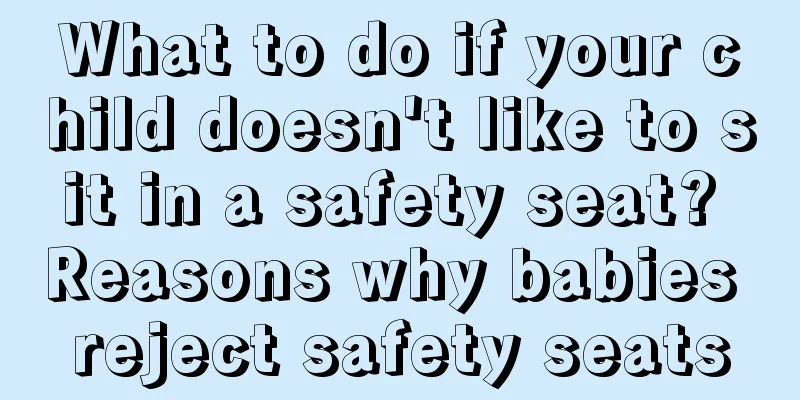What to do if your child doesn't like to sit in a safety seat? Reasons why babies reject safety seats

|
After the baby is born, if he is still relatively young, parents should provide the baby with a safety seat if they want to take the baby with them when driving out. This is also to ensure the baby's life safety. What should they do if the child is unwilling to sit in the safety seat? What to do if your child doesn't like to sit in a safety seatUse a safety seat from birth To be precise, when babies are born, they use the "predecessor" of safety seats - safety baskets. Many celebrities have set a good example in this regard - Prince William of the United Kingdom's several babies were "placed" in safety baskets by their families shortly after they were born. If the parents give the baby such a setting as soon as he is born - he must use a safety seat when riding in the car, then the baby will often accept this method from an early age and will no longer "make trouble". Because he knows that he has no choice, he will naturally not reject the safety seat. Make sure your baby is not feeling unwell Young babies are usually much more receptive to safety seats than older babies. Therefore, the sooner the baby sits in a safety seat, the better. If a baby doesn't like to sit in a safety seat, it is probably because he is uncomfortable. For example, the diaper is wet, the clothes are too tight, the sun is too glaring from the car window, the temperature in the car is too high, etc. Find the crux of the problem and solve it, and the baby will usually calm down and no longer resist the safety seat. Before letting your older baby sit in a safety seat, increase their familiarity As babies grow up, they begin to express their likes and dislikes. If you want them to have a "good impression" of the safety seat, you might as well increase the baby's familiarity with the safety seat by reading picture books, telling stories, watching videos, etc. For example, tell the baby that the safety seat is a "magic seat" with superpowers, which can effectively protect the baby's safety while the car is running. Under the guidance of their parents, most babies will gradually remove their psychological defenses and try to accept this artifact "magic seat". In addition, parents can also move the safety seat back home and play the "driving trip" game with the baby when they are free - parents are responsible for driving, and the baby sits in the safety seat to enjoy the scenery... Practice more and let the baby gradually accept the safety seat. Prepare some small games suitable for playing in the car If the journey is long, you can prepare some music, cartoons, car drawing boards, dolls, puzzle toys, steering wheel toys, etc., so that the baby can enjoy the journey better. Many babies don't want to be trapped in safety seats for a long time, often because they think riding in a car is too boring. Finally, whether the baby can accept the safety seat is also closely related to the attitude of the parents. If the parents compromise as soon as the baby cries, then you can't blame the baby for being too willful. You know, when the car is driving at high speed, no matter how strong the parents' arms are, they can't protect the safety of the child. Only by insisting on letting the baby use a safety seat can you reduce the probability of accidental injuries and "buy" the most powerful insurance for the child's travel. Reasons why babies reject safety seats1. Physiological reasons. A few months after the baby is born, there will be problems with the uneven development of the inner ears, which may cause motion sickness and vomiting when riding in a car. The baby will attribute the experience of physical discomfort to the safety seat, so he is unwilling to sit in it. 2. Psychological reasons: The baby suddenly comes into contact with the safety seat, and the unfamiliarity makes him psychologically resist. How to get your baby to accept a safety seat1. Mom and Dad can take their baby to play on swivel chairs and swings to gradually exercise the sense of balance of both inner ears. 2. Before letting your baby sit in a safety seat, parents can put the safety seat at home for a while. Let the baby see it often and sit on it like a toy, and the baby will be more likely to adapt. 3. When the baby is sitting in a safety seat, parents can give more praise and encouragement, or use toys to distract the baby. How to choose and use a safety seat1. Parents should not only use safety seats for their babies, but also install them correctly to ensure safety. 2. Babies weighing less than 13 kg or under 9 months old need to choose a safety seat that is installed in the opposite direction. To ensure travel safety, it is recommended that parents let their babies use safety seats from birth and try not to stop. In this way, the baby will gradually get used to the feeling of sitting in the safety seat and will not feel resistance. |
Recommend
What are the symptoms of premature labor?
There are many situations that women may encounte...
Why does the baby keep crying? What should I do if the baby keeps crying?
I don’t know why my baby keeps crying recently, b...
How old can babies be given complementary foods? The correct way to add complementary foods to babies
The baby is growing up day by day. Is it time to ...
What are the symptoms of dystocia?
Dystocia is a situation that every pregnant frien...
5 sensory stimulations help babies grow smart
Every parent is happy to see their baby grow smar...
Which brand of osmanthus sauce is good? Can pregnant women eat osmanthus sauce?
Osmanthus sauce is a method of pickling osmanthus...
How often should babies be fed with formula? How often should babies fed with formula eat?
After a newborn is born, some mothers will choose...
How many fingers should be opened during childbirth? What is the process of opening the fingers during childbirth?
I heard that when expectant mothers give birth, t...
What should I do if my newborn's navel is inflamed?
Newborn babies are not fully developed and are ea...
How can pregnant mothers avoid giving birth to deformed babies?
Maternal and child health experts stressed that a...
What should I do if my child is left-handed? Does my child need to be corrected?
There are always some people around us who are di...
Why do we lose our memories before the age of three? What erases our memories from infancy?
For each of us, the memory of infancy is like a f...
Do I need to fast to check progesterone and hcg? How much does it cost to check progesterone?
Many tests during pregnancy require fasting, some...
Will stretch marks disappear? Is it possible to eliminate them on their own?
Stretch marks can disappear on their own, but not...
How to treat menstrual pain, poor pregnancy, chocolate cysts
Women who are trying to get pregnant should not t...









